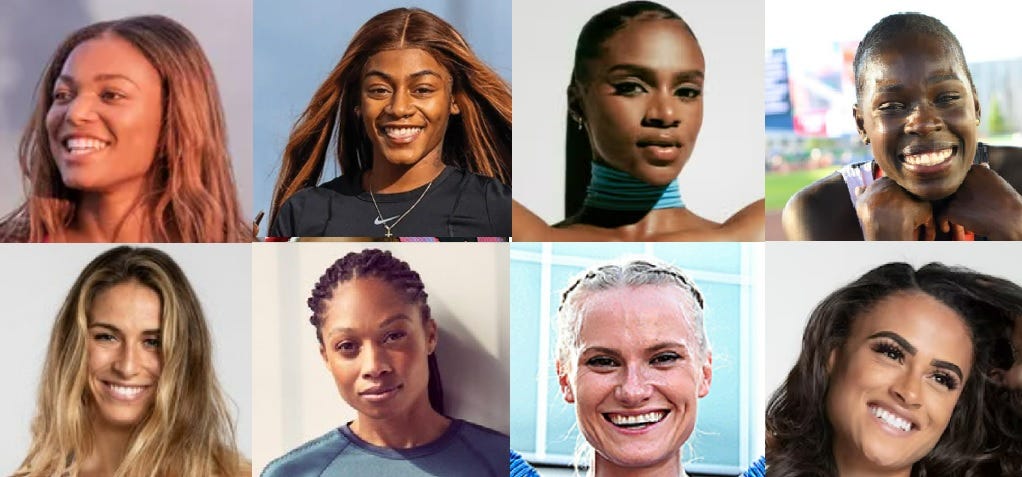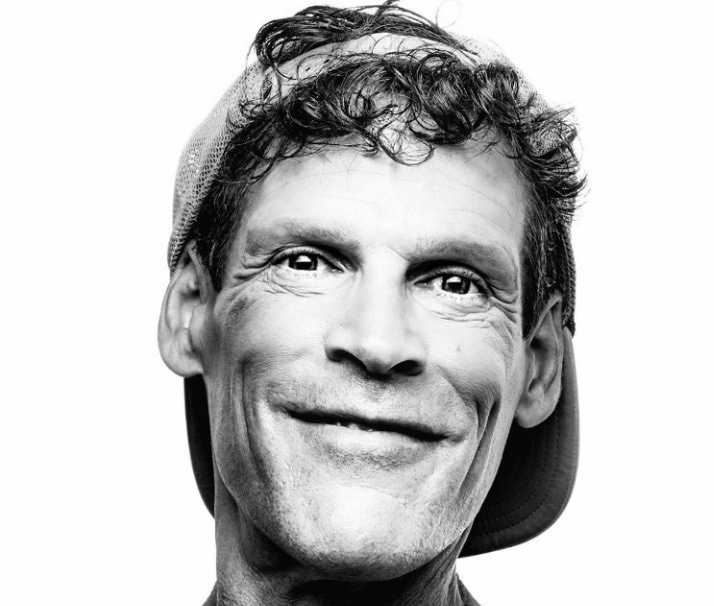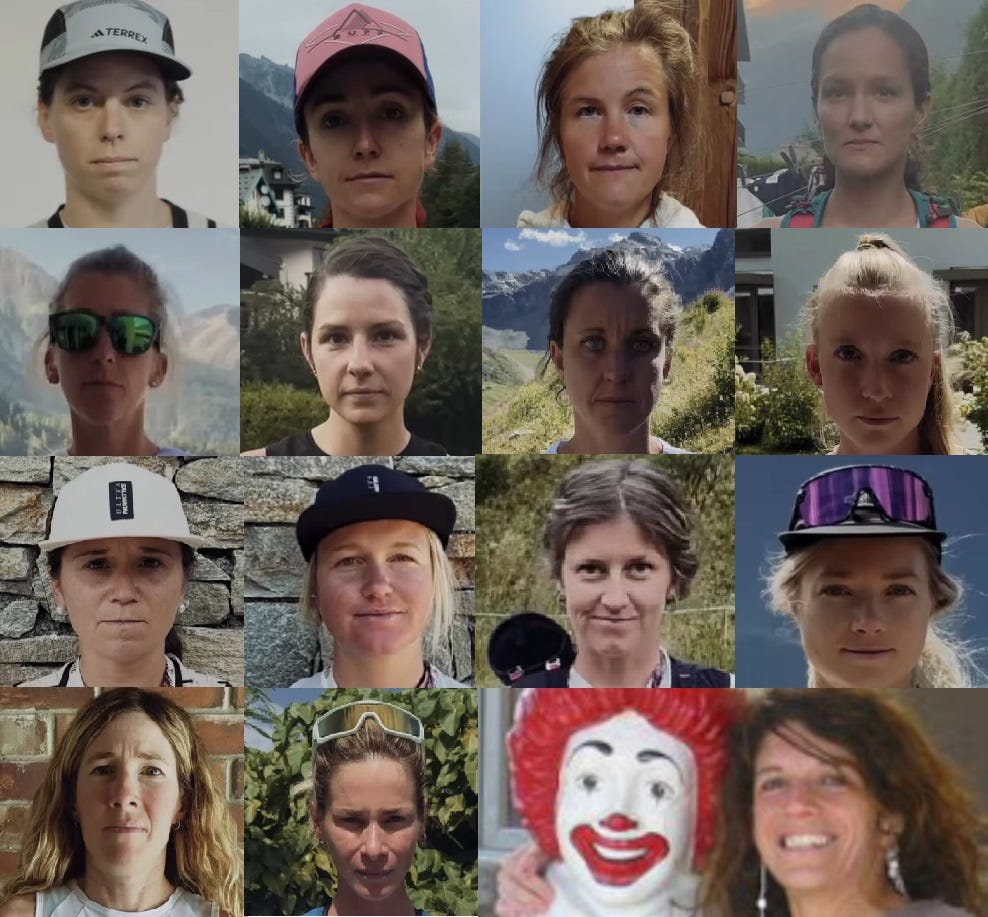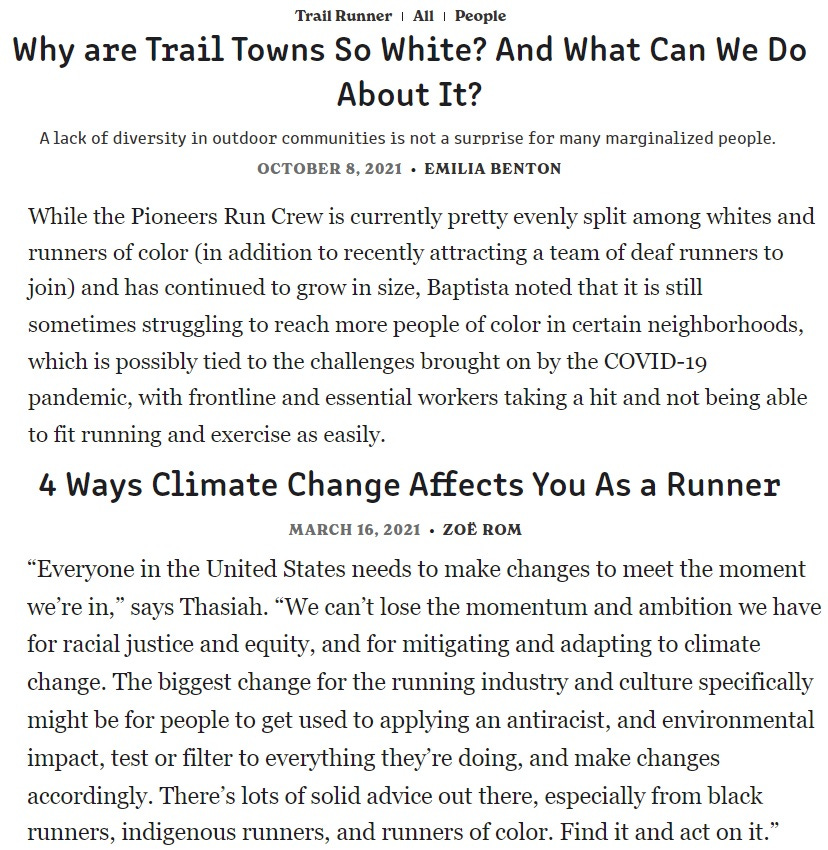A plea for attention from squad of ultrarunners combines unfounded gripes with bad marketing while revealing how serious the industry's "diversity" chatter really is
Maybe run this stuff by a focus group or two before rolling it out
Someone identifying as an athlete and Ultimate Cookie Monster named Corinne Malcolm uploaded an Instagram video last week proposing that women should receive a majority share of the overall media attention devoted to ultramarathon running. Malcolm, who also bravely stands with proponents of second breakfasts, wasn’t merely calling for equal attention; in stating that the current default is “men first” and that this needs to be inverted, she seemed to be saying it’s time for women to take a turn alone at the top of the media-attention heap.
Given the comparatively tepid level of interest in ultramarathon running even among distance runners, Malcolm was signaling perhaps seven people on the entire planet—publicists spread across approximately two official media outlets and a smattering of podcasts. The production is a demand for a larger sliver of a tiny pie, one the producers themselves manage to advertise as flavorless. And as with most broad appeals with motivations that ultimately reduce to naked self-interest, there is no way to objectively assess the outcome of this campaign, conveniently making it a cry of injustice that can be deployed in perpetuity in the service of simply wanting more time in the spotlight.
The video, for those who wisely lack an Instagram account and cannot watch its cringe-inducing content, consists of a montage of around twenty sad-looking people, mostly women, holding up pieces of paper with different words on them. The words dramatically add up to form a sentence and a now-familiar message (and I paraphrase): If the top women ultrarunners were put on display as much as male ultrarunners are, the world would learn that women are as good as men or better. (Such claims are easily adjudicated at the purest level by glancing at race results, but at this stage, who cares?)
First, it’s unclear either what this gripe is even rooted in or what “solving” it would even produce. Concerning the complaint’s origins and legitimacy, “the women of the sport are being shafted” would have qualified as a zombie-claim at least three years ago. The editors of both Trail Runner (Zoe Rom) and Ultra Running (Amy Clark) are women who appear to enjoy complete editorial freedom, which in one case has resulted in a grimly hilarious slow-motion Woke-blown catastrophe and in the other an alarmingly readable publication. In the media sources apparently most popular with ultrarunners, I seem to see as many female-centered stories about the elites at the Hardrock 100 and other big-time—and more to the point, “bad-ass”—stateside ultras as I do stories about the men winning these events.
Maybe everyone is just tired of looking at this kind of shit and won’t say so. Believe me, I cried uncle on this one while George W. Bush was still in office.
Concerning the stated desired outcome of the griping—“more coverage”—I maintain that most top ultramarathon runners don’t really want any more personal attention than they already get. Not at an organic level. The smart ones seem to go just far enough on social media to retain the sponsorships that inevitably require participation on this dismal suite of Internet sites, but you can tell that they would be content to see stories written about their wins without doing many or any interviews pertaining to their exploits. Courtney Dauwalter, despite her appearance in Malcolm’s video, seems to fit this “I will talk about me if enough others insist, and do so eloquently, but I live in the woods for a reason” mold precisely. Jim Walmsley gives consistently not just good but great interviews, mainly because he deftly steers unskilled interlocutors in the right direction, but he doesn’t strike me as someone especially keen on amplifying a personal brand,
So what is this call for “attention” here rooted in if not in sheer, unabashed narcissism?
Regardless, the video is a self-own. In the accompanying caption, there is, as usual with these gender-based complaints, no evidence adduced to the claim that women don’t get enough attention compared to men. And because the women in the video1 are forlorn-looking, slightly built white Millennials who as a rule are sporting sponsor-provided attire, it very much looks like a covey of already-haves demanding even more.
Not only are these petitioners in search of more, they seem to have forgotten en masse about a major push within the sport, a cause some of the women in the video have actively supported: The absolute need to make trail running and ultrarunning more accessible to “runners of color,” a progressive and obviously flattering term that incorporates the replacement of the deeply racist term “colored people” with the clearly more benign, if more cumbersome, designation “people of color.”
The running and fitness media been imploring us* for years to offer colored runners a greater share of the off-road- and very-long-distance-running pies. Site-specific Google searches for the term “BIPOC” return about 33 results for Trail Runner, all since 2020, and about nine for Ultra Running. Trail Runner has published around a dozen stories including the term “runners of color,” a truly ridiculous term that has summoned the most flamboyantly inane efforts of the most blinkered commentators in the biz.
I haven’t checked to see whether Alison Desir—an intellectual dead-zone and a gradually expanding zit on the ass of the sport whose “antiracism” consists of an open hatred of white people enacted though ginning up controversies founded on childishly fabricated episodes of anti-black racism—has risen up to condemn this bigoted, outright violent appeal for attention by a gaggle of melanin-deficient gals already boasting sponsorships. Or at least point out that they’re hypocrites for participating in the production, which is unlikely given Desir’s own utter absence of both credibility on this front and integrity on all fronts.
There was also no reference in the video or its caption to the fact that some the sport’s most prominent spokespeople have been eager to allow men to classify themselves as either women or altogether gender-free. (Of the few men in the video, one looked like he could almost pass for trans, but I don’t think he is.) Independent of individual stances on this, Malcolm’s mini-movement undeniably muddies the issue of exactly what kind of humans should be more energetically supported when the “give the women among us more attention” bell is runs anew.
Along the tropes in Malcolm’s caption is a tidbit about the messages she supposedly receives.
My DMs are full of parents who tell me that when they tune in to watch a race their daughters ask, “Can girls do this too?” My DMs are full of women looking to sign up for their first ultra only to find all the imagery is of men making them wonder if they belong.
Although this reeks of bullshit—it’s not hard to find super-long-distance Instagrammers with very high follower numbers—it’s fair to play along. Below are some easily unearthed photos of some of today’s most prominent American women track-and-field athletes, representing the sprints, the hurdles, the mid-distance events, the throws, the horizontal jumps, and the pole vault.

Notice anything different? No, not that, which is inevitable and somewhat fair given some of the aforementioned variables. The main difference is that these women are all connecting some combination of enjoyment and empowerment to their public presentations. The faces in Malcolm’s video all have the same potential for self-illumination, but only a couple even hint at flicking the dimmer-knob above the zero position.
I realize that track and field and ultrarunning-trail running are two different environments with different intrinsic vibes. The on-camera intensity and personalities of the women in the former are directly linked to the nature of their events, which are over quickly and invite explosive reactions to accompany explosive athletic feats. Ultrarunners, meanwhile, sometimes distribute a single competitive effort across multiple days. A naturally high-intensity, demonstrative type would probably wash out of the sport for lack of sufficient patience and concentration even if blessed with the natural ability to suffer for hours on end with no promise of finishing or any sort of reward except from whatever bubbles up from within the inner miasma of QUIT! JUST STOP, NO ONE WILL CARE! and fuck you demons, I am out here and I am trying. Fuuuuuuuuuck you.
There is undeniably some truth to the notion that people drawn to ultramarathons are primarily trying to process personal issues of body dysmorphia—many founded un unholy stories of childhood or later sexual or other abuse—while being a part of a welcoming community for the naturally community-shunning. This is neither a criticism nor a wholly external viewpoint. I would rather see people managing the chronic tug of overt lapses into anorexia and bulimia in this way than watch them resort solely to counselors’ offices, antidepressant drugs, or goal-free or very limited running—the former a somewhat goofy but well-anchored lifestyle, the latter a concession to embracing something less than maximal personal thriving.
Still, this video, while as harmless as a flock of lambs to the world at large, is just bad marketing. If young girls are really looking for evidence that ultrarunning is a fun and rewarding environment, they’re not going to get it by watching videos that are almost indistinguishable from thirty-year-old UNICEF commercials. Even if people don’t really have anything to be resentful over given observable media trends, when aiming for “We deserve more attention,” they should at least look like they really want the attention and that the sport they’re promoting is worth the media’s attention no matter which gender’s collective competitive output is most fervently glamorized by the mostly demented credentialed-pundit class.
I only saw 14 women in the video, so to complete a four-by-four grid, I had to throw in a portion of photo of a friend posing with the Maitre’d of a local eatery specializing in fine Irish cuisine.




